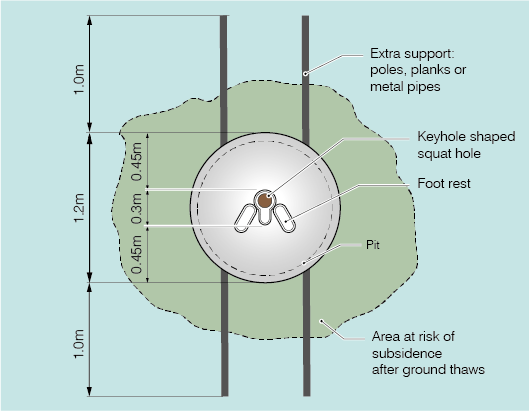
My WEDC
Gateway to managing your resources and events
Water Engineering and Development Centre
Author(s): Reed, Bob | Buttle, Mark | Smith, Mike | Shaw, Rod (ill)
This eNote introduces some of the factors that need to be considered when constructing latrines in cold climates. Methods and technical processes can be noticably different to those used in warmer or tropical regions.
Sanitation in cold regions poses two problems:
people may not wish to visit the latrine if it is someway from the house and is very cold; and
A number of solutions are possible.
Insulating the superstructure so that it retains heat may work. Decomposing excreta gives off a small quantity of heat which may be enough to prevent the latrine from freezing. VIP latrines are not suitable during winter as they will circulate cold air which will dissipate heat rising from the pit. Where VIP latrines are desirable in warmer, summer months, the pipe should be sealed as cold weather sets in.
If offset pour-flush latrines are constructed wastes could freeze in the connecting pipe. Burying it deep in the soil will help as soil is a good insulator. Nevertheless, a water-seal latrine will not generally be appropriate if it is very cold as the water will freeze and may fracture the pan.
If the area has very cold nights but warm days then light weight superstructures may be better. The latrine will be very cold at night but warm up quickly during the day.
This is particularly suitable for simple pits. If the temperature drops low enough for long enough the contents of the pit will freeze. Decomposition will stop and the wastes deposited in the pit will tend to form a pyramid! (See below). Increasing the gap between the pit contents and the floor slab will provide room for the pyramid to grow without causing offence to the user. When the temperature rises the pyramid will melt and the contents slump to a more horizontal position.
In cold regions several factors increase the rate at which sludge builds up in pit latrines, relative to the rate in warmer climates:
Calculations of pit volume use the formula:
V = N x P x R
where:
V = The sludge storage volume of the pit (m3)
N = The effective life of the pit (years)
P = The average number of people using the pit
R = The estimated sludge accumulation rate each person (m3/year)
In cold regions the value of R may be as much as double that of a warm area.
There are benefits to locating pit latrines close to human accommodation in cold regions. The close proximity will make the latrine more accessible in cold or unpleasant weather and some protection from the accommodation can help to stop cold draughts.
General construction techniques in winter can vary significantly to those used in warmer climates. For example, if concrete is not properly cured at rates suited to cold regions then it can be structurally weak and liable to collapse.
Soil that is hard and structurally sound in winter may go soft in the spring, causing collapse of latrine pits excavated when the ground is firmer. If a latrine pit is dug in winter in frozen ground that is likely to thaw in spring, steps should be taken to prevent the latrine slab from falling in. Extra support can be provided for latrine slabs by embedding two parallel sections of iron pipe, planks or poles into the surrounding soil, making sure they protrude at least 1m on either side of the hole. This spreads the load from the latrine slab over a wider area of soil, including more stable ground than that which is close to the pit sides.

Where the soil has been frozen and covered with snow, some aid agencies have successfully used digging machines mounted on the back of snow vehicles to excavate pits. Otherwise normal diggers for construction may be the only option.
For detailed construction details, refer to:
Out in the Cold: Emergency water supply and sanitation for cold regions
Established as a solution to excreta disposal problems in rural Alaska, this system is an alternative to pit latrines for when the ground conditions are such that digging pits is impossible. Heavy duty plastic bags, known as ‘honey-bags’, are used to line bucket latrines.
When a bag is full it is either:
The honey-bag system works well when outside temperatures are very cold (consistently below 0°C) but requires trucks, vehicle access to the area, and a central wastewater treatment facility. Also, with this system, water cannot be used as a method of anal cleansing, as additional unnecessary volume of waste is created: paper has to be used. In areas where water is the preferred method of anal cleansing, the honey-bag system may not be acceptable for cultural reasons.
If people (especially children) experience discomfort when hand-washing after defecation because the water is very cold, they will be tempted not to wash. Attempts should be made to make this process as pleasant as possible, by:
Disposable paper is the most hygienic method, although a place to dispose of used paper should be provide, such as a burning pit.
Keywords: Cold climate | Latrines